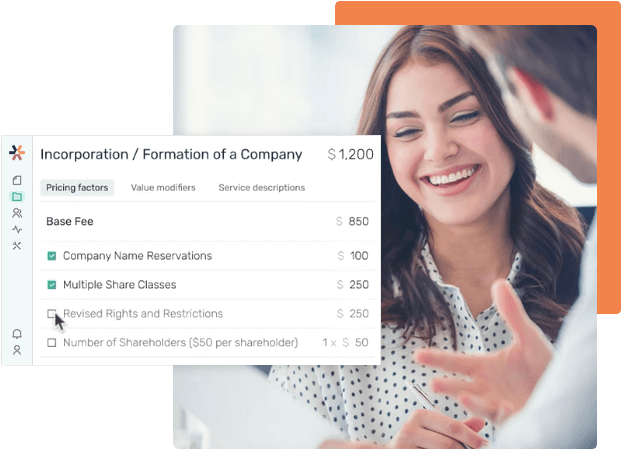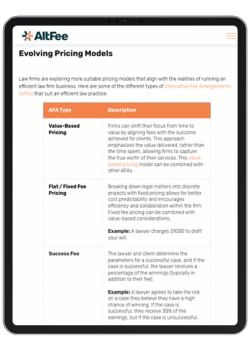- Resources
- Value Based Pricing vs Cost Based Pricing in the Legal Field
Table of Contents
When you became a lawyer, did you think that there would be such an emphasis on pricing your services?
With law firms traditionally using the billable hour model to price services, maybe you thought that you’d be among the lawyers stressing about how to meet billable hour targets set by law firms, and having to work around 10 hours a day to achieve 7.5 hours of billable work.
But thankfully, the way that the legal industry approaches pricing is changing. Now more than ever, law firms are embracing alternative fee arrangements, mainly due to a few factors:
- Client demand
- Lawyers wanting better work/life balance
- An increased focus on creating a client-centric law firm
What this means is that pricing is becoming more personalized for the individual, allowing law firms to focus more on growth without alienating any existing part of their client base.
However, switching to a value-based pricing model isn’t all sunshine and rainbows. It requires careful consideration and understanding of how your clients perceive you and the value of your services. This means that client relationships and your ability to network and collaborate with your colleagues come into play.
But, if you can get value-based pricing correct, it can result in a win-win for you and your clients: pricing potential is limitless, provided that your clients agree with you on the value you’re providing them.
In this article, we’ll explore the different types of legal pricing, with a particular focus on value based pricing vs cost based pricing. Then, we’ll take a look at the advantages and disadvantages of these cost vs value based pricing strategies, and finally look at some real-world examples of value-based pricing successes.
Types of Legal Pricing
Value Based Pricing
With value based pricing, rather than calculating your price for legal services based on an hourly rate, you price based on the client’s perceived value of your services, specifically with the value of a successful outcome. This is typically done through collaboration, experience, and research.
The concept of value is highly subjective, so figuring out how much each individual client of yours values your legal services can be tricky.
In Jonathan Stark’s Ditching Hourly podcast called Intro to Value Pricing, he outlines a few techniques that you can use to figure out how much value your client places on your services:
- Listen to them. Allow them to tell you what’s on their mind, and give you an overview of their situation.
- Ask them “why” questions. Why does this problem need to be addressed now? What are the consequences if the problem is not addressed? The point is to figure out what the client’s goals and motivations are, as knowing that information will help you gain insight into their perceived value of your services.
- Once you’ve listened to them and received answers to the questions that you’ve asked, you should now have a rough idea of what the project is worth to them, which you can then use to determine a number. You’ll likely have to draw from your experience here and potentially the experience of your colleagues. You should also understand more about the overall scope of the project at this point, which you can also use to determine what you think you should charge for this project.
So now you need to come up with a number. As an example, let’s say that you’ve determined that your client’s perceived value of the project is $75,000. Remember, you’ve landed on this number from speaking with your client, drawing from your own experience, asking your colleagues, and maybe doing some research on what others are offering for similar projects in your area.
To make sure that you’re not undercharging, at least when you’re first getting started with value-based pricing, it’s important to consider your costs for doing the project as well. This includes things like travel, paperwork, correspondence, research, and more. To continue with our example, let’s say you determined your cost for doing this project would be $2,500.
What Jonathan suggests you do now is to use this formula:
Value / 10 = Cost
As per our example: 75,000 / 10 = $7,500
So the number you present to the client as the total cost for the project would be $7,500.
The reason why you want to calculate your cost first and then the final cost at the end is so that you avoid undercharging your services. However, once you get more comfortable and gain more experience with pricing based on value, you may not even have to use a calculation anymore.
Value-based pricing in this sense might seem relatively straightforward, but the biggest challenge with it is being able to estimate what your client’s perceived value is. That’s why when faced with the choice to go with value based pricing vs cost based pricing, it seems much easier to just go with cost based.
But unlike cost-based pricing, which we’ll discuss in the next section, you can use more information to determine what that perceived value might be, including your competition, your own experience, the experience of colleagues, and general research.
Cost Based Pricing
With cost based pricing, also known as cost plus pricing, you’re taking your total calculated costs of doing a project, and then adding a percentage to that cost to make a profit. It’s a pricing strategy that aims to find the happy medium between a minimum and maximum price for a product or service using internal factors like production cost rather than external factors like consumer demand.
The cost plus pricing strategy is really common with physical products, as it’s easy to take the cost of manufacturing a product and just add a standard percentage to the top of that to gain a profit.
When we apply this pricing strategy to legal services, it’s easy to understand why lawyers may go with value based pricing vs cost based pricing.
This example from LexisNexis outlines the reasons pretty well, and highlights how a cost plus pricing strategy works in a pretty straightforward way:
- An experienced lawyer determines that setting out on her own would allow her to charge less yet make more money, as her earnings would rely entirely on her revenue and expenses, and the law firm wouldn’t be taking a cut. At the law firm, she was charging an average hourly rate of $300 per hour at 2,000 billable hours per year, which earned $600,000 for the law firm, but she was getting a salary of 250,000. Setting out on her own, she determined that she could charge less to her clients with the same number of billable hours and make even more money.
- But, after talking to an accountant and realizing that she forgot to include non-billable hours, she simply adds a cost plus percentage to her hourly rate to make up the difference.
- At the end of the year, with all of the expenses and adjustments to her hourly rate, she was able to pretty much earn the same salary that she got at the law firm.
With this background covered, let’s look at the key takeaways:
- The only way for the lawyer to truly know her costs was to wait until the end of the year. The cost-plus pricing strategy just adds a percentage to the hourly fee, rather than encouraging careful consideration of actual costs as you would with value-based pricing.
- When her sales volume changed, her “unit costs” (in this case the “unit” would be the billable hour) changed as well, which could be hard to justify to recurring clients — “my costs went up because I’m making fewer sales” or, “my costs went down because I’m doing more sales”.
- While this might not be too difficult to manage for a solo practitioner or a small law firm, imagine having to constantly calculate changing costs at a large law firm. It’s absolutely possible, but it requires intense financial reporting and the ability to run the firm within narrow cost limits.
Competition Based Pricing
With competition based pricing, a lawyer or law firm factors in what other law firms or lawyers in their area are charging for different legal services, and sets their price in close range of those prices.
While a competition based pricing strategy is straightforward, it doesn’t take into account the additional costs that a lawyer or law firm may face, such as overhead expenses, non-billable time, and more.
However, it does give you a good idea of what similar services in your area are priced at, giving you a better understanding of the local market’s demand for certain legal services. With competitive pricing, chances are you already have a good idea of what you’d like to charge for a legal service based on your experience but want to make sure that you’re not pricing yourself too high above or below the competition.
Progressive Pricing
With progressive pricing, value is tied to the price of a product or service more closely. In other words, customers are making an investment in value by paying a certain amount and expecting that value to be demonstrated in a fair and measurable return on their investment.
Progressive pricing has been adopted by all kinds of industries and businesses, from creative agencies to travel to utilities, and of course law. It shows a shift from simply billing by the hour and instead focuses more on capturing a customer’s perceived value of a product or service.
With a traditional approach to pricing (aka the billable hour) one price is set for every client, which would be a lawyer’s hourly rate. Some people might be willing to pay more, while others less. With progressive pricing, a law firm can have both more customers and more money by matching the value of the service to individual clients, which means they can service more types of clients, including previously underserved ones, without having to alienate any part of their existing audience.
Value vs Cost Based Pricing
When we compare value vs cost based pricing, we can see two distinct differences between the two. With value-based pricing, the cost (materials, labor, etc.) markup (the added amount to the cost to turn a profit), and perceived value of the product or service in the eyes of the client are considered. With cost-based or cost-plus pricing, only the cost, as well as the markup, are considered.
With that being said, we can effectively compare value based pricing vs cost based pricing by looking at each one’s advantages and disadvantages.
Let’s take a closer look at them below:
Advantages & Disadvantages of Value Based Pricing
|
Advantages |
Disadvantages |
|
Allows you to set fees for a project that doesn’t necessarily consider the time spent, meaning if you complete the project faster you earn the same amount. |
Can be difficult to determine exactly how much a client values your legal service and assign a number to that value, at least in the beginning. |
|
Supports a more client-centric approach to legal services. |
Requires more calculating and thought to be put into determining actual expenses. |
|
Provides better cost certainty for clients. |
Potential to undercharge for a project. |
|
Pricing potential is limitless, provided value can be effectively communicated. |
Advantages & Disadvantages of Cost Based Pricing
|
Advantages |
Disadvantages |
|
Straightforward and easy to understand, and it’s easy to add a percentage to an hourly rate to cover additional and unexpected expenses. |
Becomes difficult to manage for a large law firm with changing sales volumes affecting costs. |
|
Takes less time than trying to estimate client value and factoring that into cost determination. |
Doesn’t consider the client’s perception of value, competition, or other factors with determining cost. |
|
Easy to adjust up or down based on the number of sales. |
Difficult to explain fluctuating costs to recurring clients; this can impact collections and bring up difficult conversations about bills. |
|
If the project takes more time to complete then you’re earning more. |
If the project takes less time to complete then you’re earning less. |
Value Based Pricing Case Studies
Many businesses in a variety of industries have seen success by comparing cost plus pricing versus value based pricing, and determining that value based pricing was the more effective strategy. Here are a few real-world examples:
Case Study #1: Iris Pricing Solutions Helps a Client Move from Cost-Plus Pricing to Value-Based Pricing Solution
A client that typically bids on large, government-funded projects worth millions of British pounds wanted to find a way to streamline their approach to setting prices for projects while still maintaining a value-based pricing approach. Their previous approach was a cost-plus model that, at the end of the day, was based more on luck in terms of whether they’d draw a profit from the project or not.
What Iris pricing solutions did, in this case, was build the client a value-based pricing model that followed a streamlined process that could be implemented for any project.
This process followed a few key steps:
- Implementing a process for determining the total cost of a project, including factors like labor and materials
- Factoring in risk into the total cost analysis of the project, which includes unforeseen costs (a percentage was added for this by the client in the past, but it was inconsistent)
- Estimating competitor prices by analyzing previous projects and conducting a cost assessment that could be used to inform their final pricing
- Setting a final price by using the above information, as well as value mapping to evaluate competitor benefits vs their estimated prices for similar projects, and using that information to set a clear price range
This new process was implemented in the client’s sales process through collaboration with management and resulted in the client winning more projects. They were also able to increase their overall profitability on said projects through increased process efficiency and the ability to set more consistent prices for their clients.
Case Study #2: Freelancer Increases Project Pricing from $3K – $20K by Using Value-Based Pricing
Starting way back in 2009, a web development freelancer named Wil Brown started out pricing his projects like any other freelancer would: start small, then raise your prices as needed. He started out by using a cost-plus pricing strategy, which seemed to work well at the time. Basically, as websites became more complicated and required more time to create, he would increase his prices accordingly. In Brown’s first three years of business, his prices went from $500 – $2,500, which showed good promise for growth.
Although his price increases were in line with his competitors and were based on the time needed to create effective websites for his customers, he soon found himself struggling to get customer acceptance on projects that he priced over $3,000. On top of that, customers were requesting more features and integrations — meaning that the work was taking longer and becoming more complex than ever before. What’s more, he knew that others were charging $10,000+ for their projects and having no issues getting customers.
Basically, a cost-plus pricing strategy was no longer working. Brown was now priced at the bottom of his market and needed to break through that $3,000 price ceiling. So why the change? A combination of his clients lacking urgency and Wil doing a poor job of conveying value to his clients.
Freelancers do this all the time — price based on their time rather than the value they provide to the client. As Brown quickly realized, pricing based on his time wasn’t working, as the only metric that the client had to go off of was his time — he wasn’t effectively conveying his professional value in terms of skills, ability, etc.
The result, in this case, was that Brown compared value-based pricing vs cost based pricing, and decided that value based was the better pricing strategy. He would take the time to qualify clients and learn more about how much value they placed on his services, then price his services accordingly. Through value pricing, he was able to break into pricing his projects in the $20,000+ range.
Key Takeaways of Value Based Pricing vs Cost Based Pricing
In terms of cost versus value based pricing, it’s clear that the latter works better as a pricing strategy for both solo lawyers and law firms. Not only does adopting value based pricing show your clients that you understand their urgency, concerns, motivations, and goals, but it also helps you price based on what you’re worth.
With value pricing, scalability and growth are never capped: it’s a completely future-proof pricing strategy. The reason? Pricing is based on the client’s individual perception of value and based on your experience, quality, and skillset, rather than solely on time spent. In other words, when you can effectively convey a high level of value to your clients, your earning potential is unlimited.
Key steps to figuring out a value based law firm pricing strategy include:
- Listening to your client, and gaining an understanding of their issue(s), then asking them effective “why” or probing questions. Why solve this problem now? What are the potential consequences if this problem isn’t solved in the near future?
- Use this information to determine your client’s goals and motivations. If you can understand both of these important pieces of information, then you’ll have a much better idea of the value they place on your services.
- At this point, you should have a good idea of the scope of the project. Use this information to calculate your costs (materials, time, stress, etc.). This may not be needed as you gain more experience with using a value based pricing approach.
- Now that you have your cost, it’s time to assign a number to your client’s perception of the project’s value. You may want to talk to colleagues and do additional research to help you set a number if you feel you need more information at this point.
- Once you’ve set a value price for the project, divide that number by 10 to get the cost that you should present to your client.
The other part of an effective value-based pricing strategy is having the right legal technology to manage and collaborate on your different pricing structures. AltFee offers an easy way to not only quickly get started with alternative pricing arrangements, but also to incorporate collaboration with other legal professionals in your firm with regard to pricing.
If you’re ready for a more efficient and systemized way of managing your law firm’s pricing, then reach out to AltFee today for a complete product demo.
Start Earning More Revenue with Fixed Fees
Break free from hourly pricing and take the fear out of scoping and pricing client projects to start maximizing profitability.
Book A Demo







Newsletter Signup
Subscribe to our newsletter to receive the latest news.



